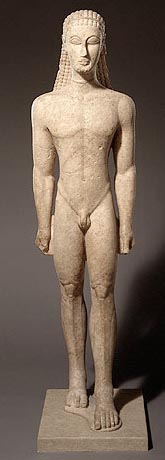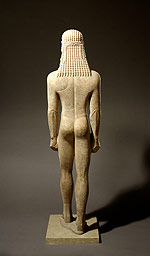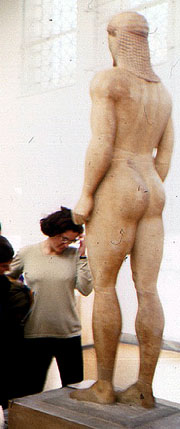Greek sculptors were at work in marble on the islands of Naxos, Paros, and
Samos before the end of the seventh century BCE, and, before long, evidence of
their work appears on the mainland, too. The two major types of sculpture in
the round prevalent in the sixth century BC were the standing nude male, the
kouros (plural, kouroi) and the standing clothed female,
the kore (plural, korai). Throughout the period, the kouros develops on one level from over-lifesize abstraction to more naturalistic human proportions and scale. On another level sculptors were attacking the issue of how best to represent divine beauty in human form, the ideal in the real.
The kouroi stood in sanctuaries or cemeteries, occasionally as representations of divinities (at one time they were all thought to be images of Apollo), but most often as votive offerings to the gods, or as commemorative markers over graves. Towering, vibrant statues, they stood four square with one leg advanced and arms by their sides, held straight or slightly bent with fists
clenched.

New York Kouros
said to be from Attica
Marble, Height 6 feet
c. 600 BCE
(Metropolitan Museum of Art, New York)


Anavysos Kouros
from Anavysos, Attica
Height 6 feet 41/2 inches
c. 530 BCE
marble
(National Archaeological Museum, Athens)


Aristodikos Kouros
from Attica
Height 6 feet 5 inches
c. 500 BCE
(National Archaeological Museum, Athens)


 SPRING 2016
SPRING 2016  SCHEDULE
SCHEDULE  REQUIREMENTS
REQUIREMENTS

 SPRING 2016
SPRING 2016  SCHEDULE
SCHEDULE  REQUIREMENTS
REQUIREMENTS